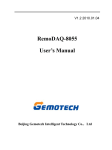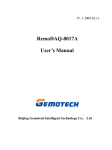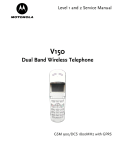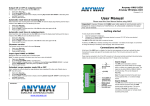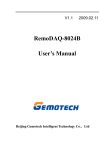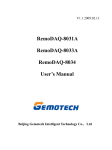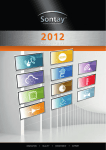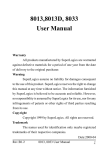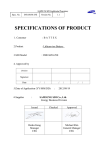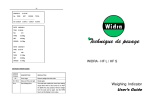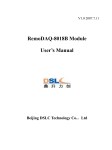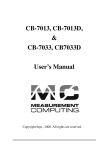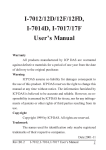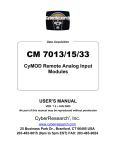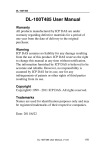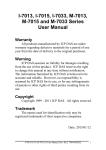Download "user manual"
Transcript
V1.1 2010.2.2 RemoDAQ-8031/8031D RemoDAQ-8033/8033D RemoDAQ-8036 User’s Manual Beijing Gemotech Intelligent Technology Co.,Ltd RemoDAQ-8031/33/36 Series User’s Manual Copyright Notice This document is copyrighted, 2005, by Beijing Gemotech Intelligent Technology Co.,Ltd All rights are reserved. Beijing Gemotech Intelligent Technology Co. , Ltd reserves the right to make improvements to the products described in this manual at any time without notice. No part of this manual may be reproduced, copied, translated or transmitted in any form or by any means without the prior written permission of Beijing Gemotech Intelligent Technology Co.,Ltd. Information provided in this manual is intended to be accurate and reliable. However, Beijing Gemotech Intelligent Technology Co.,Ltd assumes no responsibility for its use, or for any infringements upon the rights of third parties, which may result from its use. Acknowledgments RemoDAQ is a trademark of Beijing Gemotech Intelligent Technology Co.,Ltd. Edition 1.1 Feb. 2010 1 RemoDAQ-8031/33/36 Series User’s Manual Additional Information and Assistance 1. Visit the gemotech websites at www. gemotech. cn where you can find the latest information about the product. 2. Contact your distributor, sales representative, or gemotech 's customer service center for technical support if you need additional assistance. Please have the following information ready before you call: z Product name and serial number z Description of your peripheral attachments z Description of your software (operating system, version,application software, etc.) z A complete description of the problem z The exact wording of any error messages 2 RemoDAQ-8031/33/36 Series User’s Manual Table of Contents 1 Introduction .............................................................................................. 4 1.1 Pin Assignment & Specifications .............................................. 5 1.2 Block Diagram ........................................................................... 9 1.3 Application Wiring .................................................................. 10 1.4 Default Setting ......................................................................... 12 1.5 Calibration................................................................................ 12 1.6 Install List ................................................................................ 13 2 Initialization & Installation .................................................................... 17 2.1 Installation Guideline............................................................... 17 2.2 Software Installation ................................................................ 17 2.3 Basic configuration and hook-up............................................. 18 2.4 Baudrate and Checksum .......................................................... 20 3 Command Set ......................................................................................... 22 3.1 %AANNTTCCFF .................................................................... 25 3.2 #AA .......................................................................................... 27 3.3 #AAN ....................................................................................... 28 3.4 $AA0 ........................................................................................ 29 3.5 $AA1 ........................................................................................ 30 3.6 $AA2 ........................................................................................ 31 3.7 $AA8 ........................................................................................ 32 3.8 $AA8V ..................................................................................... 33 3.9 $AA9(Data).............................................................................. 34 3.10 $AAF...................................................................................... 35 3.11 $AAM .................................................................................... 36 3.12 ~AAO(Data)........................................................................... 37 3.13 ~AAEV .................................................................................. 38 3 RemoDAQ-8031/33/36 Series User’s Manual 1 Introduction The RemoDAQ-8000 Series is a set of intelligent sensor to computer interface modules containing built in microprocessor. They are remotely controlled through a simple set of commands issued in ASCII format and transmitted in RS-485 protocol. They provide signal conditioning, isolation, ranging, A/D and D/A conversion, data comparison, digital communication, timer/counter, wireless communication, collection AC and other functions. RemoDAQ-8031 RTD Module RemoDAQ-8031 RTD input module supports one RTD input channel for temperature measurement. This module can accept 2 wire, 3 wire or 4 wire RTD sensor. The module offers signal conditioning, A/D conversion, ranging, and RS-485 digital communication functions.. RemoDAQ-8036 6-channel RTD Input Module A RTD module is popular for temperature measurement. Unlike the traditional design, the RemoDAQ-8036 provides six RTD input channels for different types of RTD signal as an effective solution in industrial & building automation. Usually, broken external wiring will lead to inaccurate current value. The RemoDAQ-8036 provides a broken wiring detecting function so users can easily troubleshoot broken wiring problems. This module can accept 2 wires or 3 wires RTD sensor. RemoDAQ-8031D is the RemoDAQ-8031 with a 4½ digit LED display; RemoDAQ-8033 is a three channel RTD input module. RemoDAQ-8033D is the RemoDAQ-8033 with a 4½ digit LED display. 4 RemoDAQ-8031/33/36 Series User’s Manual 1.1 Pin Assignment & Specifications RemoDAQ-8031/8031D Specifications: Input channel Input type RTD type Output Speed (in bps) Maximum distance Conversion rate Bandwidth Accuracy Zero drift Span drift CMR@50/60Hz NMR@50/60Hz Isolation voltage 1 2,3 or 4 wire Pt100a = 0.00385;Pt100a=0.003916;Cu100;Cu50 RS-485 (2-wire) 1200,2400,4800,9600,19.2K,38.4K,57.6K,115.2K 4000ft. (1200m.) 10samples/sec 5.24Hz ±0.05% or better 0.5µV/°C 1.0µV /°C 150dB 100dB 3000VDC 5 RemoDAQ-8031/33/36 Series User’s Manual Displayed LED 4½ digits (for R-8031D) Power supply 10~30VDC Power consumption 0.7W(R-8031);1.3W(R-8031D) Operating Temperature:-20 ~ 70° C Environment Humidity:5 ~ 95%, non-condensing RemoDAQ-8033/8033D Specifications: Input channel Input type RTD type Output Speed (in bps) Maximum distance Conversion rate Bandwidth Accuracy Zero drift 3 2,3 or 4 wire Pt100a = 0.00385;Pt100a=0.003916;Cu100;Cu50 RS-485 (2-wire) 1200,2400,4800,9600,19.2K,38.4K,57.6K,115.2K 4000ft. (1200m.) 15/12.5samples/sec (60/50Hz) 5.24Hz ±0.1% or better 0.5µV/°C 6 RemoDAQ-8031/33/36 Series User’s Manual Span drift CMR@50/60Hz NMR@50/60Hz Isolation voltage Displayed LED Power supply Power consumption Environment 1.0µV /°C 150dB 100dB 3000VDC 4½ digits (for R-8031D) 10~30VDC 1.0W(R-8033);1.6W(R-8033D) Operating Temperature:-20 ~ 70° C Humidity:5 ~ 95%, non-condensing RemoDAQ-8036 Specifications: Input channel Input type RTD type Output 6 2, 3 wire Pt100a = 0.00385;Pt100a=0.003916;Cu100;Cu50 RS-485 (2-wire) 7 RemoDAQ-8031/33/36 Series User’s Manual Speed (in bps) Maximum distance Conversion rate Bandwidth Accuracy Zero drift Span drift CMR@50/60Hz NMR@50/60Hz Isolation voltage Power supply Power consumption I/O connector type Environment 1200,2400,4800,9600,19.2K,38.4K,57.6K,115.2K 4000ft. (1200m.) 10 samples/sec (60/50Hz) 5.24Hz ±0.05% or better 0.5µV/°C 1.0µV /°C 150dB 100dB 3000VDC 10~30VDC 1W 13-pin plug-terminal Operating Temperature:-20 ~ 70° C Humidity:5 ~ 95%, non-condensing 8 RemoDAQ-8031/33/36 Series User’s Manual 1.2 Block Diagram 9 RemoDAQ-8031/33/36 Series User’s Manual 1.3 Application Wiring 2-wire RTD connection R-8031/31D/33/33D 2-wire RTD connection R-8036 10 RemoDAQ-8031/33/36 Series User’s Manual 3-wire RTD connection (R-8031/31D/33/33D) 3-wire RTD connection (R-8036) 11 RemoDAQ-8031/33/36 Series User’s Manual 4-wire RTD connection (R-8031/31D/33/33D) 1.4 Default Setting z Address:01 z RTD type:Type 20,Pt100,-100℃~+100℃ z Baudrate:9600 bps z Checksum disable,60Hz rejection,engineering unit format z Filter at 60 Hz rejection (except R-8036) 1.5 Calibration What do you need to do calibration? 1. One 5 1/2 digital multimeter. 2. A voltage calibrator or very stable and noise free DC voltage generator. 3. A precision resistance decade box or discrete resistors. 4. RemoDAQ-8000 Utility Type Zero calibration 12 Span calibration RemoDAQ-8031/33/36 Series User’s Manual 20~27 2B~2F 0 Ohms 0 Ohms 375 Ohms 0 Ohms Calibrate Order: 1. 2. 3. 4. 5. 6. 7. 8. Apply power to the module and let it warm up for about 30 minutes Setting type Enable calibration Apply zero calibration resistance Perform zero calibration command Apply span calibration resistance Perform span calibration command Repeat step 3 to step 6 three times. The calibration order with other types is to it similar, but in first step installation type from time to time place difference. Notice: 1. Through 2-wire RTD connection calibrate resistance. 2. For RemoDAQ-8036, join resistance on 0 channel. 1.6 Install List Baudrate Setting (CC) Code 03 04 05 06 07 08 09 0A Baudrate 1200 2400 4800 9600 19200 38400 57600 115200 RTD type setting (TT) Code RTD type 20 Platinum100,a=0.00385 13 Temperature Range -100 ~ 100 RemoDAQ-8031/33/36 Series User’s Manual 21 22 23 24 25 26 27 2B 2C Platinum100,a=0.00385 Platinum100,a=0.00385 Platinum100,a=0.00385 Platinum100,a=0.003916 Platinum100,a=0.003916 Platinum100,a=0.003916 Platinum100,a=0.003916 Cu100 Cu50 0 ~ 100 0 ~ 200 0 ~ 600 -100 ~ 100 0 ~ 100 0 ~ 200 0 ~ 600 -50~150 -50 ~ 150 Data format setting(FF) 7 6 5 4 3 2 *1 *2 0 *1:0=60Hz Restrain 1=50Hz Restrain *2:Checksum:0=Disabled 1=Enable *3:00 = Engineering Unit Format 01 = Percentage Format 10 = 2’s Complement HEX Format 11 = Ohms 14 1 0 *3 RemoDAQ-8031/33/36 Series User’s Manual Analog Input Type And Data Format Table Code Input span Platinum 100 20 a=0.00385 -100~100℃ Platinum 100 21 a=0.00385 0~100℃ Platinum 100 22 a=0.00385 0~200℃ Platinum 100 23 a=0.00385 0~600℃ Platinum 100 24 a=0.003916 -100~100℃ 25 Data format +F.S. -F.S Project Unit +100.00 -100.00 %(FSR) +100.00 -100.00 2’s Complement HEX 7FFF 8000 Ohm +138.50 +060.60 Project Unit +100.00 +000.00 %(FSR) +100.00 +000.00 2’s Complement HEX 7FFF 0000 Ohm +138.50 +100.00 Project Unit +200.00 +000.00 %(FSR) +100.00 +000.00 2’s Complement HEX 7FFF 0000 Ohm +175.84 +100.00 Project Unit +600.00 +000.00 %(FSR) +100.00 +000.00 2’s Complement HEX 7FFF 8000 Ohm +313.59 +060.00 Project Unit +100.00 -100.00 %(FSR) +100.00 -100.00 2’s Complement HEX 7FFF 8000 Ohm +139.16 +060.60 Platinum 100 Project Unit +100.00 +000.00 a=0.003916 %(FSR) +100.00 +000.00 15 RemoDAQ-8031/33/36 Series User’s Manual 0~100℃ Platinum 100 26 a=0.003916 0~200℃ Platinum 100 27 a=0.003916 0~600℃ 2B Cu100 2’s Complement HEX 7FFF 0000 Ohm +139.16 +100.00 Project Unit +200.00 +000.00 +000.00 %(FSR) +100.00 2’s Complement HEX 7FFF 0000 Ohm +177.13 +100.00 Project Unit +600.00 +000.00 %(FSR) +100.00 +000.00 2’s Complement HEX 7FFF 0000 Ohm +317.28 +100.00 Project Unit +150.00 -050.00 %(FSR) +100.00 -033.33 -50~150℃ 2’s Complement HEX Ohm 2C 7FFF D554 +164.27 +078.49 Project Unit +150.00 -50.00 Cu50 %(FSR) +100.00 -033.33 0~100℃ 2’s Complement HEX 7FFF D554 Ohm +082.13 +039.24 RTD Over range / Under range Reading Over rang Under range Project Unit +9999 -0000 %(FSR) +9999 -0000 2’s Complement HEX 7FFF 8000 16 RemoDAQ-8031/33/36 Series User’s Manual 2 Initialization & Installation 2.1 Installation Guideline Figure 2-1 Power Supply Connections We advise that the following standard colors (as indicated on the modules) be used for power lines: +Vs (R) Red GND (B) Black We advice that the following standard colors (as indicated on the modules) be used for the communication lines: DATA+ (Y) Yellow DATA- (G) Green 2.2 Software Installation 1. 2. 3. If you have already installed “RemoDAQ-8000 Utility” then skip other steps. Backup your software diskette. Insert “RemoDAQ-8000 Utility” disc into CD-ROM: 17 RemoDAQ-8031/33/36 Series User’s Manual 4. 5. 6. Change drive to the path of CD-ROM. For example, your drive of CD-ROM is F:then change the drive to F: Find the setup of “RemoDAQ-8000 Utility” and run it. Please follow the steps of setup program then you can successfully install the RemoDAQ-8000 Utility 2.3 Basic configuration and hook-up Before placing a module in an existing network, the module should be configured. Though all modules are initially configured at the factory, it is recommended to check that the baud rate is set correctly. Default Factory Settings Baud rate: 9600 Bit/sec. Address: 01 (hexadecimal) Checksum:disable The basic hook-up for module configuration is shown below. Figure 2-2 Layout for Initialization the RemoDAQ module 18 RemoDAQ-8031/33/36 Series User’s Manual The following items are required to configure a module:a RemoDAQ converter module, a personal computer with RS232 port (baudrate set to 9600) and theRemoDAQ utility software. Configuration with the RemoDAQ Utility Software The easiest way to configure the RemoDAQ module is by using the RemoDAQ utility software:an easy-to-use menustructured program will guide you through every step of the configuration. Configuration with the RemoDAQ command set RemoDAQ modules can also be configured by issuing direct commands from a terminal emulation program within what is part of the RemoDAQ utility software. The following example guides you through the setup of an analog input module. Assume that RemoDAQ-8031 still has its default settings (baud rate 9600 and address 01h). Before the module is reconfigured, it is first requested to send its default settings. To change the configuration setting of the analog input module, the following command is issued: %0107200600(cr) % = change configuration 01 = target module at address 00 to: 07 = change address to 07 hexadecimal 20 = set input range to Type 20 06 = set baud rate to 9600 00 = set integration time to 50 ms (60 Hz) 19 RemoDAQ-8031/33/36 Series User’s Manual disable checksum set data format to engineering units (See Chapter 3, Command Set for a full description of the syntax of the configuration command for module) When the module received the configuration command it will respond with its new address:!07(cr) NOTICE: All reconfiguration except changing of baud rate and checksum values can be done dynamically, i.e. the modules need not to be reset. When changing the baud rate or checksum, these changes should be made for all connected devices. After reconfiguration, all modules should be powered down and powered up to force a reboot and let the changes take effect. 2.4 Baudrate and Checksum RemoDAQ modules contain EEPROMs to store configuration information and calibration constants. The EEPROM replaces the usual array of switches and ports required to specify baudrate, input/output range etc. All of the RemoDAQ modules can be configured remotely through their communication ports, without having to physically alter port or switch settings. Forcing the module in the INIT* state does not change any parameters in the module’s EEPROM. When the module is in the INIT* state with its INIT* and GND terminals shorted, all 20 RemoDAQ-8031/33/36 Series User’s Manual configuration settings can be changed and the module will respond to all other commands normally. Changing Baud rate and Checksum Baud rate and checksum settings have several things in common: ¾ ¾ They should be the same for all modules and host computer. Their setting can only be changed by putting a module in the INIT* state. ¾ Changed settings can only take effect after a module is rebooted To alter baudrate or checksum settings you must perform the following steps: ¾ Power on all components except the RemoDAQ Module. ¾ Power the RemoDAQ module on while shorting the INIT* and GND terminals ¾ Wait at least 7 seconds to let self calibration and ranging take effect. ¾ Configure the checksum status and/or the baud rate. ¾ Switch the power to the RemoDAQ Module OFF. ¾ Remove the grounding of the INIT* terminal and power the module on. ¾ Wait at least 7 seconds to let self calibration and ranging take effect. ¾ Check the settings (If the baud rate has changed, the settings on the host computer should be changed accordingly.) 21 RemoDAQ-8031/33/36 Series User’s Manual 3 Command Set Introduction To avoid communication conflicts when several devices try to send data at the same time, all actions are instigated by the host computer. The basic form is a command/response protocol with the host initiating the sequence. When modules are not transmitting they are in listen mode. The host issues a command to a module with a specified address and waits a certain amount of time for the module to respond. If no response arrives, a timeout aborts the sequence and returns control to the host. Changing RemoDAQ’s configuration might require the module to perform auto calibration before changes can take effect. Especially when changing the range, the module has to perform all stages of auto calibration that it also performs when booted. When this process is under way, the module does not respond to any other commands. The command set includes the exact delays that might occur when modules are reconfigured. Syntax [delimiter character][address][command][data][checksum] [carriage return] Every command begins with a delimiter character. There are four valid characters:a dollar sign $, a pound sign #, a percentage sign % and an at sign @. 22 RemoDAQ-8031/33/36 Series User’s Manual The delimiter character is followed by a two-character address (hexadecimal) that specifies the target module. The actual two-character command follows the address. Depending on the command, an optional data segment follows the command string. An optional two character checksum may be appended to the total string. Every command is terminated by a carriage return (cr). Calculate Checksum: 1. Calculate ASCII sum of all characters of command(or response) string except the character return(cr). 2. Mask the sum of string with 0ffh. Example: Command string:$012(cr) Sum of string=‘$’+‘0’+‘1’+‘2’=24h+30h+31h+32h=B7h The checksum is B7h,and [CHK] = “B7” Command string with checksum:$012B7(cr) Response string:!01200600(cr) Sum of string:‘!’+‘0’+‘1’+‘2’+‘0’+‘0’+‘6’+‘0’+‘0’ =1h+30h+31h+32h+30h+30h+36h+30h+30h=1AAh The checksum is AAh,and [CHK] = “AA” Response string with checksum:!01200600AA(cr) 23 RemoDAQ-8031/33/36 Series User’s Manual General Command Sets Command Syntax Command Name %AANNTTCCFF #AA #AAN $AA0 $AA1 $AA2 $AA8 $AA8V $AA9(data) $AAF $AAM ~AAO(data) ~AAEV Configuration Command Description Sets the address,input range, baudrate,dataformat,checksum status Return the input value from the module in the currently configured data format Return the input value from the Analog data in module channels N in the currently configured data format Calibrates an AI module to correct Span calibration for gain errors Calibrates an AI module to correct Zero Calibration for gain errors Return the configuration parameters for Configuration status the module Read the LED configuration which determines whether LED will Read LED configuration display data from the module or from the host computer Set the LED configuration which determines whether LED will Set LED configuration display data from the module or from the host computer The computer sends data to the Send LED data module to display on its LED Read firmware version Return the firmware version code Read module name Return the module name Set module name Return correct or error Enable/Disable Return correct or error calibration Analog data in 24 Notes 3.1 3.2 3.3 3.4 3.5 3.6 3.7 3.8 3.9 3.10 3.11 3.12 3.13 RemoDAQ-8031/33/36 Series User’s Manual 3.1 %AANNTTCCFF Name:Configuration Description:Sets address, type code, baudrate, data format Syntax:%AANNTTCCFF(cr) % delimiter character. AA address of setting module (00-FF) NN New address (00-FF) TT New type CC New baudrate FF New data format When changing baudrate or checksum, we should INIT* termination land. 7 6 5 4 3 2 1 0 Not used Checksum status 0: Disable 1: Enable 0=60Hz Restrain 1=50Hz Restrain 00=Engineering Unit Format 01= Percentage Format 10= 2’s Complement HEX 11= Ohms Figure 3-1 Data format setting of AI modules Response:!AA(cr) if the command was valid. ?AA(cr) if an invalid operation was entered. if the INIT* terminal was not grounded when attempting to change baud rate or checksum settings. Syntax error or communication error may get no response. 25 RemoDAQ-8031/33/36 Series User’s Manual ! command is valid. ? command is invalid. AA address of setting module (00-FF) (cr) is the terminating character, carriage return (0Dh) Example: Command:%0102200600(cr) Response:!02(cr) Change address from 01 to 02,an input type 20, baud rate 9600, integration time 50 ms (60 Hz), engineering units data format and no checksum checking or generation. The response indicates that the command was received. Table 3-1 Input Rang Codes (Type Code) Code RTD type Temperature Range 20 Platinum100,a=0.00385 -100 ~ 100 21 Platinum100,a=0.00385 0 ~ 100 22 Platinum100,a=0.00385 0 ~ 200 23 Platinum100,a=0.00385 0 ~ 600 24 Platinum100,a=0.003916 -100 ~ 100 25 Platinum100,a=0.003916 0 ~ 100 26 Platinum100,a=0.003916 0 ~ 200 27 Platinum100,a=0.003916 0 ~ 600 2B Cu100 -50~150 2C Cu50 -50 ~ 150 Table 3-2 Baudrate Code Code 03 04 05 06 07 Baudrate 1200 2400 4800 9600 19200 26 08 09 0A 38400 57600 115200 RemoDAQ-8031/33/36 Series User’s Manual 3.2 #AA Name:Analog Data In Description:Command will return the input value from module in the currently configured data format. Syntax #AA(cr) # delimiter character. AA address of reading module(00~FF) (cr) is the terminating character, carriage return (0Dh). Response:>(data)(cr) Syntax error or communication error may get no response. > delimiter character. data AI input value,the data is the combination for each channel respectively Example: Command:#01 Response:>+02.555 Read analog input value at address 01, return with +02.555 Command:#04 Response:>+02.422+05.457+04.654 Read analog input value at address 04(R-8033/33D), return values of 3 channels 27 RemoDAQ-8031/33/36 Series User’s Manual 3.3 #AAN Name:Analog Data From channel N Description:The command will return the input value from one of the 8 channels of a specified (AA) module in the currently configured data format. Syntax:#AAN(cr) # delimiter character. AA address of reading module(00~FF) N channel (0~7) (cr) is the terminating character, carriage return (0Dh). Response:>(data)(cr) Syntax error or communication error may get no response. > delimiter character. data AI input value.(For data formats, refer sec.1.7). Example: Command:#32 Response:>+02.455 Read address 03 and channel 2, return +02.455 Command:#28 Response:?02 Read address 02 and channel 8, return error channel number. Notice:Command only for RemoDAQ-8033/33D/36 28 RemoDAQ-8031/33/36 Series User’s Manual 3.4 $AA0 Name:Span Calibration Description:Calibrates module to correct for gain errors Syntax:$AA0(cr) $ delimiter character. AA address of the module that is to be calibrated(00~FF) 0 span calibration command. (cr) the terminating character, carriage return (0Dh). Response:!AA(cr) if the command was valid. ?AA(cr) if an invalid operation was entered. Syntax error or communication error may get no response. ! command is valid. ? command is invalid. AA address of the module (00~FF) In order to successfully calibrate an analog input module’s input range, a proper calibration input signal should be connected to the analog input module before and during the calibration. Example: Command:$010 Response:!01 Span calibration of address 01,return success Command:$020 Response:?02 Span calibration of address 02,return the calibration is not enable before span calibration command. 29 RemoDAQ-8031/33/36 Series User’s Manual 3.5 $AA1 Name:Zero Calibration Description:Calibrates module to correct for gain errors. Syntax:$AA1 (cr) $ delimiter character. AA address of the module that is to be calibrated(00~FF) 1 zero calibration command. (cr) the terminating character, carriage return (0Dh). Response:!AA(cr) if the command was valid. ?AA(cr) if an invalid operation was entered. Syntax error or communication error may get no response. ! command is valid. ? command is invalid. AA address of the module (00~FF) In order to successfully calibrate an analog input module’s input range, a proper calibration input signal should be connected to the analog input module before and during the calibration. Example: Command:$011 Response:!01 Zero calibration of address 01,return success Command:$021 Response:?02 Zero calibration of address 02,return the calibration is not enable before span calibration command. 30 RemoDAQ-8031/33/36 Series User’s Manual 3.6 $AA2 Name:Configuration Status Description:The command requests the return of the configuration data from the analog input module at address AA. Syntax:$AA2(cr) $ delimiter character. AA address of reading module(00~FF) 2 the Configuration Status command. (cr) the terminating character, carriage return (0Dh). Response:!AATTCCFF(cr) if the command is valid. ?AA(cr) if an invalid operation was entered. Syntax error or communication error may get no response. ! command is valid. ? command is invalid. AA address of module(00~FF) TT represents the type code. CC represents the baud rate code. FF data format (Also see the %AANNTTCCFF configuration command) Example: Command:$012 Response:!01200600 Read address 01 configuration,return success. 31 RemoDAQ-8031/33/36 Series User’s Manual 3.7 $AA8 Name:Read LED Data Origin Description:Read the LED Data Origin status that determines whether LED will display data from the module directly or from the host computer. Syntax:$AA8 (cr) $ is a delimiter character. AA address of reading module(00~FF) 8 identifies the Read LED Data Origin command. (cr) is the terminating character, carriage return (0Dh) Response:!AAV(cr) if the command was valid. ?AA(cr) if an invalid operation was entered. Syntax error or communication error may get no response. ! command is valid. ? command is invalid. AA address of the module (00~FF) V LED configuration. For R-8031D:1=module control,2=host control For R-8033D:0~2=display channel,3=host control Example: Command:$018 Receive:!011 Read address 01 LED configuration,return module control. Notice:Command only for RemoDAQ-8031D/33D 32 RemoDAQ-8031/33/36 Series User’s Manual 3.8 $AA8V Name:Select LED Data Origin Description:Select whether LED will display data from the module directly or from the host computer. Syntax:$AA8V (cr) $ is a delimiter character. AA address of reading module(00~FF) 8 identifies the Select LED Data Origin command. V LED configuration. For R-8031D:1=module control,2=host control For R-8033D:0~2=display channel,3=host control (cr) is the terminating character, carriage return (0Dh) Response:!AA(cr) if the command was valid. ?AA(cr) if an invalid operation was entered. Syntax error or communication error may get no response. ! command is valid. ? command is invalid. AA address of the module (00~FF) Example: Command:$0182 Receive:!01 Set address 01 LED to host control,return success. Notice:Command only for RemoDAQ-8031D/33D 33 RemoDAQ-8031/33/36 Series User’s Manual 3.9 $AA9(Data) Name:Send Data to LED Description:The host computer sends data to the addressed module to display on its LED. Syntax:$AA9(data)(cr) $ is a delimiter character. AA address of setting module(00~FF) 9 identifies the Send LED Data command. Data data for show on the LED,from -19999. to +19999. The data format is sign,5 numerical and decimal point. (cr) is the terminating character, carriage return (0Dh) Response:!AA(cr) if the command was valid. ?AA(cr) if an invalid operation was entered. Syntax error or communication error may get no response. ! command is valid. ? command is invalid. AA address of the module (00~FF) Example: Command:$019+123.45 Receive:!01 Send address 01 LED data +123.45,return success. Command:$029+512.34 Receive:?02 Send address 02 LED data +512.34,return the LED is not setting in the host mode. Notice:Command only for RemoDAQ-8031D/33D 34 RemoDAQ-8031/33/36 Series User’s Manual 3.10 $AAF Name:Read Firmware Version Description:The command requests the module at address AA to return the version code of its firmware. Syntax:$AAF (cr) $ delimiter character. AA address of reading module(00~FF) F identifies the version command. (cr) is the terminating character, carriage return (ODh) Response: !AA(data)(cr) if the command is valid. ?AA (cr) if an invalid command was issued. Syntax error or communication error may get no response. ! command is valid. ? command is invalid. AA address of response module(00~FF) Data is the version code of the module’s firmware. Example: Command:$01F Receive:!01051201 Read address 01 firmware version,return version 051201 Command:$02F Receive:!01040101 Read address 02 firmware version,return version 040101 35 RemoDAQ-8031/33/36 Series User’s Manual 3.11 $AAM Name:Read Module Name Description:The command requests the module at address AA to return its name. Syntax: $AAM (cr) $ delimiter character. AA address of reading module(00~FF) M the Read Module Name command. (cr) is the terminating character, carriage return (ODh) Response:!AA(data)(cr) if the command is valid. ?AA(cr) if an invalid command was issued. Syntax error or communication error may get no response. ! command is valid. ? command is invalid. AA address of response module(00~FF) data the name of the module Example: Command:$01M Receive:!018031 Read address 01 module name,return name 8031. Command:$03M Receive:!038036 Read address 03 module name,return name 8036. 36 RemoDAQ-8031/33/36 Series User’s Manual 3.12 ~AAO(Data) Name:Set Module Name Description:Set the module name and return success or error. Syntax:~AAO(Data) (cr) $ delimiter character. AA address of setting module(00~FF) O Set Module Name command. Data new name for module,max 6 characters (cr) is the terminating character, carriage return (ODh) Response:!AA(cr) if the command is valid. ?AA(cr) if an invalid command was issued. Syntax error or communication error may get no response. ! command is valid. ? command is invalid. AA address of response module(00~FF) Example: Command:~01O8031 Receive:!01 Set address 01 module name to 8031,return success. Command:$01M Receive:!018031 Read address 01 module name,return 8031. 37 RemoDAQ-8031/33/36 Series User’s Manual 3.13 ~AAEV Name:Enable/Disable Calibration Syntax:~AAEV (cr) $ delimiter character. AA address of reading module(00~FF) E Enable/Disable calibration command. V 1=Enable 0=Disable (cr) is the terminating character, carriage return (ODh) Response:!AA(cr) if the command is valid. ?AA(cr) if an invalid command was issued. Syntax error or communication error may get no response. ! command is valid. ? command is invalid. AA address of response module(00~FF) Example: Command:$010 Receive:?01 Perform address 01 span calibration,return the command is invalid before enable calibration. Command:~01E1 Receive:!01 Set address 01 to enable calibration,return success. Command:$010 Receive:!01 Perform address 01 span calibration,return success. 38







































